

By Lora Koenig
Yesterday was an exciting day in the office. While I was downloading satellite data, answering e-mails and tying up loose ends before leaving for Antarctica, I was also closely following the NASA Airborne Sciences Flight Tracker and the flight path of the NASA DC-8 aircraft. The DC-8 is currently flying over Antarctica as part of the Operation IceBridge mission and yesterday it overflew the 2010 SEAT traverse line and ice core drilling sites. (For more detailed info on Operation IceBridge, check out the mission’s website).
I spent part of the day yesterday watching my screen as the flight tracker showed a little green aircraft moving over our 2010 route. Here is the aircraft approaching our line at about 1:40 PM Eastern time. (The tracker was not updating the plane image at this time, but the aircraft was at the end of the red line.)
Here it is halfway through. (Note that the plane does a 270-degree turn to line up on our traverse line to make sure it is leveled as it crosses our 2010 ice core sites. This ensures the best quality of radar data.)
And here is the plane at about 2:35 PM EST, finishing the portion of its flight that retraced our traverse and four ice core locations:
I watched on my screen as the IceBridge plane covered in just less than an hour the same ground that took us 12 days to cover last year.
OK, so I guess you are asking yourself: Why do we go out in the field, in sub-freezing weather, to drive around on snowmobiles for 12 days to do what a plane can do in an hour? Because you can not drill an ice core from an airplane. The airplane carries radars, which provide great spatial coverage of radar data, but we need to calibrate the radar data with the annual cycles we get from ice cores. (See last week’s blog post on how we determine annual cycles in the lab). So, yesterday, IceBridge collected great radar data that will compare to the data from our ice core sites, as well as to data from the WAIS divide ice core and the ice cores collected by a group led by Dr. Ian Joughin at University of Washington.
The IceBridge DC-8 aircraft flies with radars that are nearly identical to the ones we use on the ground. They are named Snow Radar and Ku-band Radar and are built by the Center for Remote Sensing of Ice Sheets, CReSIS. We will use the airborne radar data gathered yesterday to investigate any differences between what the radars are measuring from the air and on the ground.
In a week, we board our flights to Antarctica. After watching the IceBridge plane flying in West Antarctica yesterday, I am even more excited to get my boots on the ice.
By Lora Koenig
Two weeks ago, I traveled to Utah to help the team finalize planning for this season and to visit the ice core lab and our 2010 ice cores at BYU. The entire was there, except for Ludo, who was in Hawaii competing in a triathlon. (Ludo is not only a top scientist but a top triathlete. I hope he is not getting too use to the warm weather because in less than a month he will be facing temperatures around 0°F.)
There were a few tasks to complete in Utah. The first was to look at many different types of satellite data on the region where we will be traveling to make sure there aren’t any crevasses or other dangers along the route. A crevasse is a crack in the ice. As the ice flows (yes, ice flows just like a mound of putty), it can crack when it goes over a bump or accelerates. Here is a recent picture of crevasses in Western Antarctica, from a NASA Operation IceBridge flight.
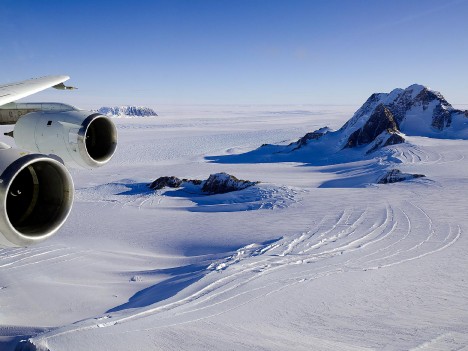
As you can imagine, we would not want to drive a snowmobile in an area like this. So we spent hours looking over maps of the rock bed under the ice sheet to look for bumps, visible and radar satellite images of the surface of the ice sheet, and satellite data showing the velocity of ice flow to make sure that we are traveling on the safest possible route. We ended up moving one ice core drilling location slightly to avoid a dark spot that we could not clearly identify in one of the radar images, just to be extra cautious. Once the route was established, we generated waypoints (coordinates) every kilometer to load into the GPS units that we will use for navigation. The place we are going to is big, white and flat: It is very easy to lose your sense of direction, so we rely heavily on GPS units for navigation.
For some great images and videos on how ice flows in Antarctica please check out this video, made by our NASA colleague Eric Rignot who (thanks again, Eric!) also checked the data that sits behind these videos to help ensure our safe route.
If you would like an in-depth look, this file, which opens on Google Earth, shows our final route with points every 1 km.
Our second task in Utah was to visit last year’s ice cores and have our first meeting to discuss the initial data coming from them. First, here is a picture of a core in the field, taken in December 2010.
In this photo, Michelle (right) is labeling the core and I (left) am getting the core tube ready for storage. The arrow on the ice core bag shows which direction is up. It is very important that all the cores are labeled in order, or we would lose our time series. The metallic tube in the center left of the picture protects the core during shipping. The core in the tube gets placed in the white core box sitting open on the left side of the picture. (Also, notice that Michelle is standing on a bright green pad to help insulate her feet from the cold snow. It’s a veteran trick for keeping your toes warm.)
Here is that same core in the lab today.
Summer is holding what was about 8 feet of the core and the rest of the about 50 feet of core is stacked in the boxes behind her, waiting for analysis.
Here is a very basic explanation of what happens to the cores once they arrive at Summer’s lab at BYU. (Normally, Summer would be the one writing this, but she is currently studying glaciers in Bhutan.)
When the core arrives, we put it in the freezer. Here is Landon peering out of the freezer door:
In the freezer, we weigh the core to determine its density and measure its electrical conductivity, which tells us about its chemical composition. A volcanic event would be detected in the cores by the electrical conductivity and can be used to set a point in time. We take all these measurements twice, or even three times, to make sure they are accurate.
Here is a picture of a core that Landon is preparing, sitting on the freezer’s core handling tray:
This freezer is set to -4°F, so when not posing for a picture, Landon would normally be in a parka with gloves on. As you can see, the core is still in its protective bag, which will be removed when actually processing the core. From here, the core is cut up into sections less than an inch (2 cm) long, and melted for the next stage of analysis.
I will add a quick note here that on last year’s traverse Landon was our lead driller. Both Landon and Jessica are masters students at BYU. They are not only integral players of the field teams, but are also the lead students for the lab analysis of these cores.
Once we have melted the core and put it in a bottle, we send it over to Jessica.
Here is Jessica operating the mass spectrometer (black box to the left in the picture with the blue screen) that will measure the stable water isotopes used to date the core. The isotopes in the snow have an annual cycle and it is this cycle that determines age of the core. An isotope is an atom, in our case an oxygen atom, that has different variations with different number of neutrons and atomic numbers. Oxygen has three stable isotopes: 16O, 17O, and 18O. The peaks and valleys in the ratios of 18O/16O reflect the warmer (summer) and cooler (winter) temperatures, respectively. Once the mass spectrometer determines the number of isotopes, we can establish the age of the core, in a way similar to counting tree rings. During this process, the core is in the little blue vials just to the right of Jessica.
After spending some time in the lab, we looked at the data from the first core that has been analyzed. At this point the density and isotopes have been measured and Summer is carefully working to put together the depth-age scale, which is the age of the core at each depth where the core use to sit in the ice sheet. I will use the density data from the core to determine an age-depth scale from the layers in the radar data and if all goes well the radar and ice core will line up giving us confidence in our analysis.
Last Monday, when I returned to Goddard, I had received my travel itinerary. We will be leaving the U.S. on Nov 17th to make our journey down to Antarctica. With all of this preparation, I am eagerly awaiting getting my feet on the Ice.
By Summer Ruper
Hello SEAT blog followers. I am Summer Ruper, and I would like to share with you a little bit of the ice coring adventure that begins well before the field team heads to Antarctica. Before we start drilling ice cores in the harsh cold and wind of Antarctica, we have to train our field team on the drill and sampling procedures. To do this, we took a trip to a slightly warmer region with ice: Athabasca Glacier in the Columbia Ice Field. Athabasca Glacier is near the Canadian town of Banff, and is one of the most visited glaciers in the world. It’s a beautiful area, and plenty of ice to play with.
To begin, we must first answer the question: What is an ice core? Simply put, it is a core sample collected from a glacier or ice sheet. But the ice core is not entirely made up of ice; with the snow fall and wind also come dust, salts, and even ash from volcanic eruptions. All of this is contained in the ice cores and provides information about how snowfall, temperature, and winds have changed over time. A lot of important information is buried in the ice and snow on glaciers and ice sheets, but you have to get the ice out in order to get at that information.
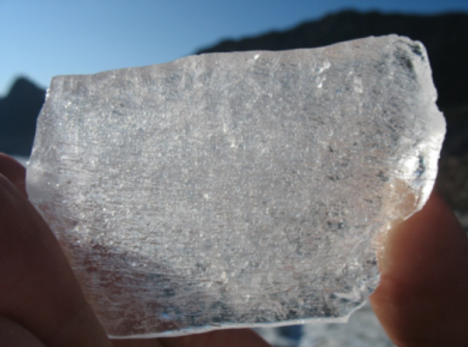
In order to collect the ice cores, we use a specially designed ice core drill. The one we use is called the FELICS, and is designed and manufactured by Felix and Dieter Stampfli in Switzerland. Basically, the drill has a sharp ring on the end that cuts the ice and feeds the core into a one-meter long barrel. We pull the one-meter section up, empty it out of the barrel, and then drill another one-meter ice core from the bottom of the hole. We do this over and over again until we have drilled to a depth of about 20 meters, and have about 20 one-meter long ice cores.

On Athabasca Glacier, our field crew learned how to operate the drill, handle the ice cores, and generally deal with problems that might arise. We were also able to show the tourists visiting that glacier how the drill worked, let them see (and taste) the ice, and share a little of our knowledge and excitement about glaciers and the environmental records contained in the ice. We had a lot of fun, and Jessica and Randy are excited to transfer this experience to our work on the Antarctic ice sheet soon.

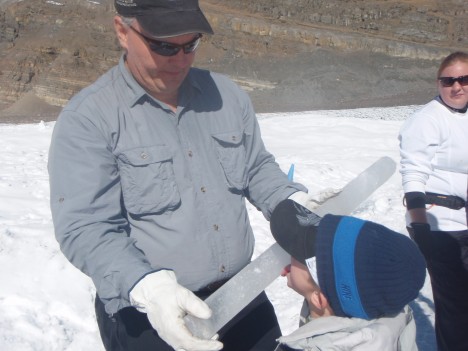
In another post, we will show you what we do with the ice cores once they return to the lab and share some of our preliminary results from last year’s ice cores.

By Lora Koenig
Hello! My name is Lora Koenig and I would like to welcome you to our Satellite Era Accumulation Traverse blog. I know that is a mouthful so we will call it the SEAT blog. So have a SEAT, grab a hot drink, and enjoy the blog. From now until mid-January, my colleagues and I will tell you about our science and adventures, from preparing our gear in the U.S. to riding snowmobiles across West Antarctica in order to study how much snow falls in Antarctica. You will hear about our team’s journey to Antarctica, the science we are doing and share in the fun we have while conducting field work in the coldest, driest, remotest and, forgive the pun, coolest continent on Earth. We are headed to the West Antarctica Ice Sheet, to a place called Byrd Station.
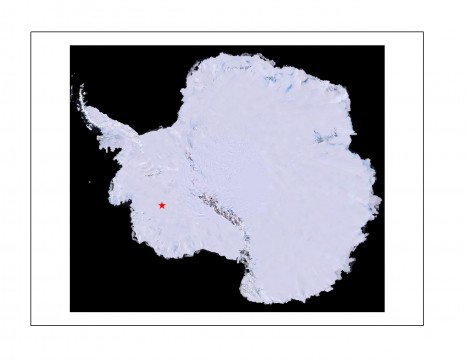
I suppose I should start with a short background of why exactly we are headed off to Antarctica and what we plan on doing there. But first a question: Have you ever wondered how we measure snow fall in Antarctica? It is actually rather difficult because, quite frankly, there are not a lot of people around with rulers. In the interior of the ice sheet, where we are headed, the snow falls each year and creates layers like a stack of pancakes — one pancake per year. The best way to measure snowfall, or accumulation, is by using ice cores that drill into the snow. Think of taking a straw and sticking it into your stack of pancakes and then measuring the thickness of each pancake. During this project we will be taking ice cores as well as using radars, that image the snow layers between the ice cores to measure accumulation rate, how much snow fell each year, over the past 30 years, the satellite era. It is our goal to use the data we get from our field-work to be able to better measure accumulation directly from satellites in the future.
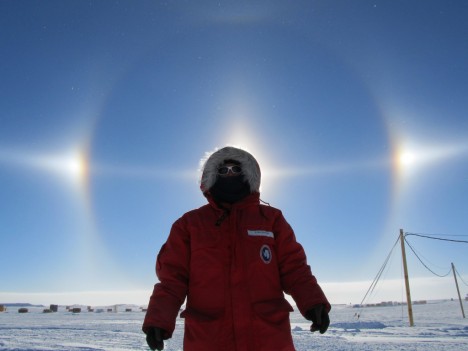
That was a short introduction to the science. We will give you many more details as this blog develops between now and the end of the traverse in January 2011. For now I want to introduce you to the team. This project is funded by the National Science Foundation and NASA so we have team members from both NASA Goddard Space Flight Center and universities. The team members this season include: Jessica Williams, Randy Skinner and Summer Rupper from Brigham Young University; Clément Miège and Rick Forster from the University of Utah; Michelle Koutnik from the University of Copenhagen; and Ludovic Brucker and me, from Goddard Space Flight Center. In the next post, we will tell you about testing the ice core drill in Canada and preparing the radars for their trip to Antarctica. But first, meet the team:
Hi, my name is Jessica Williams and I just started my master’s degree at Brigham Young University in the Department of Geological Sciences. I am currently working with Dr. Summer Rupper looking at the snow and ice records from the surface of Antarctica. I am excited to go to Antarctica to drill some ice cores to take back to the lab at BYU to study. Using a combination of density, electrical conductivity, and isotope records from the ice cores we will be able to get snow accumulation rates in West Antarctica. In preparation for this trip I went to Switzerland and Canada to practice using the drill and to gain experience living on the ice.
My name is Randy Skinner and I am a geology professor at Brigham Young University in Provo, Utah. On an annual basis I instruct nearly 1,000 students, most in basic geology 101 classes. In Antarctica I will be involved in helping to obtain ice cores and digging snow pits. The ice cores will penetrate down to a depth of 20 meters. We will drill 10 of these cores while making our traverse of several hundred kilometers in western Antarctica. The cores and information from the snow pits will be used to determine rates of snow accumulation. I am very excited to be a part of this research, and to bring these experiences back to share with my future students.
Hi! I am Summer Rupper, and I am a professor in the geology department at Brigham Young University, Utah. My research is largely focused on the interplay between glaciers and climate. In particular for our work in Antarctica, my students and I are using the physical and chemical properties of ice to reconstruct the past 30-40 years of temperature and snow accumulation rates. I was in Antarctica last year helping our team drill ice cores for this research. This year, I, along with my students, will be continuing the processing of those ice cores in our freezer lab at Brigham Young, while the rest of the team heads back to Antarctica to collect more cores. I am very excited to have such a great team going to Antarctica again this year, and can’t wait to hear all about their adventures upon their safe return.
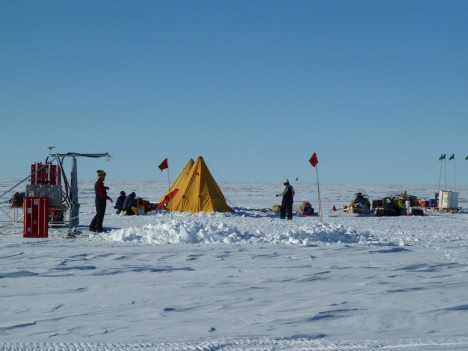
My name is Michelle Koutnik and I work at the Center for Ice and Climate at the University of Copenhagen in Denmark. I grew up in Southern California, but now I enjoy living in Northern Europe. I was in Antarctica last season as part of this project and I look forward to a second traverse across Central West Antarctica. I use computer models of ice-sheet flow to understand ice-sheet evolution over tens of thousands of years. This project is different because we focus on ice-sheet evolution over tens of years. I have been working on a computer model focused in the region of Antarctica that we will be doing field work — I am excited for a real trip there instead of just a virtual one! It will be great to face the challenges of the Antarctic environment and also to work with this team to accomplish our goals.
I am Clément Miège, a PhD student in the Department of Geography at the University of Utah. I am originally from France and I am currently working with Dr. Richard Forster on Greenland and Antarctic snow accumulation patterns. This year will be my second Antarctic field season. During this traverse, I will operate 2 high-frequency radars, in order to produce images of internal snow/firn layers. Later, those images will be used, with the help of ice cores, to give us snow accumulation rates. So we will be able to understand 30-40 years of history for this part of the ice sheet. I am very excited to be on this traverse to keep exploring Antarctica and share this extraordinary experience!!
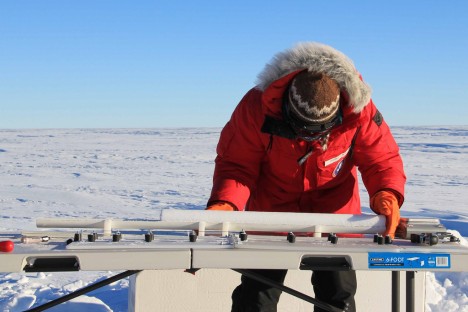
Hi there! I’m Ludovic Brucker, one of the French citizens on the team. I came to the US in early 2010 after defending my PhD on passive microwave remote sensing of Antarctic snow. I’m currently a scientist at NASA Goddard Earth Sciences Technology and Research (GESTAR) Studies and Investigations, Universities Space Research Association (USRA), Greenbelt, MD. This season sounds incredibly exciting and I look forward to our deployment on the West Antarctic Ice Sheet to conduct a 400 miles (~650 km) scientific traverse with snow mobiles! After three years studying the evolution of Antarctic snow properties through the use of satellite observations, I’ll now have a chance to see how the snow really looks! I can’t wait to be on the ice and see how correct, or not, my ideas of Antarctica are!
My name is Lora Koenig and I am a physical scientist in the Cryospheric Sciences Branch at NASA’s Goddard Space Flight Center. I am a remote-sensing glaciologist who uses satellites to monitor the ice sheets and I am always interested in how well measurements from space compare to those taken on the ground. My interest in ground truth data and learning more about ice sheets will take me to Antarctica for a third time this season. I have always loved snow and ice. I started skiing in the Pacific Northwest before I started school and my love for being in cold outdoor places continued into graduate school where I studied topics dealing with both seasonal snow and the polar ice sheets. My expertise is in microwave remote sensing of the ice sheets.